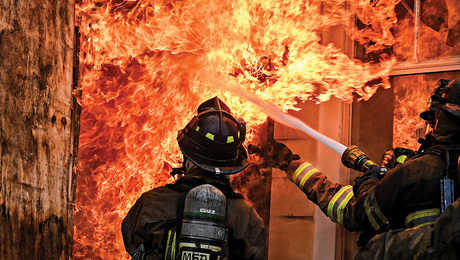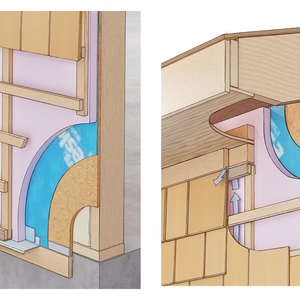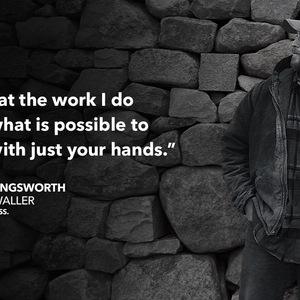Suspected we had a leak in plumbing; tried to run an air pressure test on it, and system would hold absolutely no pressure. It held 100 psi for 24 hrs to pass inspection last spring. Since then we had wallboard installed and trimwork and kitchen cabinets installed. they all required a lot of screws through the walls. (No dry wall screws for the cabinets.)
Suspect that cabinet installer did the job, running a big ol’ honkin’ wood screw into PVC pipe.
Is there any way to locate a hidden leak in a wall cavity w/o turning on water and looking for stains? I can perform some simple tests and isolate the system it is in, ie, hot or cold; section of the house. But, that being done, I still have to locate the precise location in a wall cavity.
Don



















Replies
don... once you isolate it... i would think you could hear the air escaping with a stethascope to further locate it...
Mike Smith Rhode Island : Design / Build / Repair / Restore
If you can get your hands on a doctor type stethescope [sp?] you should be able to listen for it. Hopefully you know the plumbing lay out. Excessive back ground noise can be filtered some with a folded paper towel.
You could kill the water and use air pressure. Escapeing air will sound more like a whistle or a hiss.
first of all is the leak in the water system or dwv system?
if you you suspect the dwv in the kitchen area, the leak should be easy to find, vent pipes for the kitchen sink are usually right next to the window, just remove the cabinet in that area and check for screws in the wrong place by removing a small section of drywall behind the cabinet
ive installed cabinets for 15 years and its easy to confuse a stud with abs or pvc pipe, although an experienced installer wil notice a difference in the way a screw goes into the wall if he hits a pipe
a drywall screw is a lot more difficult to locate, and a finishing nail almost imposible
if the offending item is still in the pipe the pipe shouldnt leak until it rusts away which should take at least a year(unfortunately)
i suggest first a frank no blame attached discussion with the cabinet installer, did he drive a screw some where that "felt funny" and removed it?
the fix is relatively easy if the cabinet guy did it, remove the cabinet, locate the hole and fill with 5 minute epoxy
fix it now of course, a friend of mine installed a kitchen a few years ago not realizing he drove a 3 inch screw into a drain pipe from an upstairs bathroom, the screw rusted away over 3 years and created a leak, ruining drywall, a really nice tile job and some cabinets as well
steve
"caulking is not a piece of trim" by zach gaulkin 1998 in memorium
Steve: Cabinet installer would have no idea whatsoever if he hit a pipe. We have ICF walls, and to solve problems finding the furring strips installed over 5/8 ply. Installer couldn't find furring strips to hang ply; went absolutely berserk trying. He must have drilled a hundred holes fishing for furring. May not even be a screw in pipe - could be just a drilled hole. I had to find furring for him, since I built the walls, & knew where to look. Used 1 1/2 # 10 wood screws to hang ply. THey probably shattered the pipe, since it will not build up any pressure at all using my small compressor.
Don
The GlassMasterworks - If it scratches, I etch it!
Don, How about a larger compressor or one with a large air tank. Hook it up far enough away so that it is quiet in the house, build up alot of air and have someone connect it while you are listening in the house. Screw an air adapter to your plumbing so you can hook it up directly and you are free to wander. This must be your water system since it previously was pressured to 100 lbs. Did you disconnect your water heater? That might lead you to think that no pressure was building using the small compressor.
I'm a little confused by the comment that you suspect a shattered pipe. What kind of piping is it that is not holding pressure?
Good Hunting
Based on the action in the system so far, it won't help. We got air to go up to about 15 psi at first; bled off to zero in less than 5 seconds. Now, nothing. This tells me that the pipe is now totally open somewhere. Probably split open from a screw hole or crack when we pressurized it. Sorta like a short circuit in an electrical circuit - no voltage because of no resistance. PVC & CPVC pipe will do that - copper will not.
This AM, wife, who can hear, took a real medical stethoscope & listened at the spot in the wall, inside a kitchen cabinet, where all the pipes, hot & cold, run down the wall. She heard a rushing sound that got louder as I pumped in air. It was so bad that I could even hear it. Unfortunately, it only pinpoints the section of wall, not the exact spot. Doesn't make it any easier to fix - we still have to take out the same number of cabinets; namely all of them; remove plywood, cut into sheetrock and fix the forschlagenen thing. AAAAAARRRRRRRRRRRGGGGGG! That's OK - I'll be a better person for having done it.
Thanks - your advice makes sense for a reasonably sized hole.
DonThe GlassMasterworks - If it scratches, I etch it!
Edited 7/5/2003 1:15:17 PM ET by Don
Now here's the other part of the post I am wondering about. Who pays for the mistake? The cabinet installer, the Builder, the homeowner, or the Insurance Company?
What's everone's take on this.
I've installed MANY kitchens and I have never drilled into a water line. But I did drill in to a drain line once( in my own house...go figure). But then again we use copper and the plumbers usually use nailing plates to protect pipes(but not always)
One good recommendation to everyone is to take photos of the walls before the are plastered/drywalled. This includes electrical, plumbing, hvac, etc. Sure makes troubleshooting easier. Can't remember how/where the pipe was run? pull out the photos, they usually tell. I worked for a great general contractor years ago while working for someone else. One of the other guys installing the kitchen hit the supply line to the refer. It ruined about 125sq' of Limestone flooring. The general pulled out the Polaroid photos, traced the pipe, cut out the back of the cabinet, soldered the leak, firetaped the drywall, and put in a new false back. This took less than 3 hours. Never did any harm to the cabinets, counters, back splash(all granite) or the kitchen flooring. The limestone in the family room was ruined. The GC paid for the new material. He didn't even back charge my boss. Said it wasn't our fault. Said it was part of cost of running a job. The flooring guy did a small token barter my boss. A few bathroom cabinets for flooring labor. Home owner never even knew about the incident. What they don't know, won't hurt them
I ran a drywall screw into a copper water pipe once--it was my own place, too, thank bog. The pipe was running through a stud, and I was too lazy to go get the 1" gyprock screws from the shop when I had a pouch full of 1½". That extra half-inch is what did me in.
I noticed the small dripping leak at the bottom of the wall just as I was about to lay on the ceramic wall tile! Stopped, unscrewed the substrate (plywood, in this case), sweated in a new section of pipe, and went back to work on the tile job.
I have never since run any pipes or wires through a stud without installing protecting plates on the face of every stud through which they pass. I learned my lesson the hard way, but I got off easy all the same.
As far as assigning blame: If the scenario turns out to be the same in this case--pipe traversing a stud & screw correctly placed in the stud but hitting the pipe as well--it sounds like the plumber didn't protect the pipes and ought to eat the biscuit. On the other hand, if the pipe is running up alongside the stud and the cabinet installer missed the stud and hit the pipe, that's another story, and the plumber is in the clear.
I don't see why the homeowner should have to foot the bill; and if the HO's house insurance policy covers this, I'd like to see the clause and know the name of the company! Maybe the plumber's or cabinet installer's professional insurance would cover it?
Dinosaur
'Y-a-tu de la justice dans ce maudit monde?
Dino: In this case, the HO/GC/plumber will eat the cost. The walls are ICF's, and the pipe is between steel furring strips, just barely code distance below the wall surface because of the depth of the concrete limiting where the pipes can fit.
The cabinet installer had no patience and went berserk trying to find the furring strips. The stress of getting the cabinet installer to do a repair job or pay for the repairs isn't worth it. I'll just wait till we finish the house except for the kitchen and then, at my own pace, remove everything, find the spot and do the repair. For all I know, it may be several holes in several pipes. From the number of random holes he drilled to find furring strips it could be a dozen.
Wife's stethoscope work only confirms that air moves in the vicinity of the pipes. It could be flowing along the pipe to the top of the wall to escape and she heard it burbling along in the voids around the pipe. I guess if we keep moving down pipe till we hear nothing we will have reached the source of the air. I think I will install some access panels in the wall space above the cabinets - we have at least a foot due to the 9 ft ceilings.
No matter what we find, I am going to do a heck of a lot of analysis and troubleshooting before cutting open walls. Like isolating the leak to either hot or cold pipes and cutting into an available pipe in attic space and sticking in a valve so I can confirm what section of the house the leak is in. The HVAC guys cracked a fitting installing a humidifier tap - at least it was visible and readily repaired.
DonThe GlassMasterworks - If it scratches, I etch it!
It's your call--but from your description, it sounds like the installer was OC. Yeah, OK you chose him, that makes it your responsibility, and you're the GC, too, which makes everything your responsibility. But last I heard a GC could sue a sub if the sub screwed up. If he didn't know how to handle ICF's he should have either asked someone who did, or refused the job.Dinosaur
'Y-a-tu de la justice dans ce maudit monde?
Don
You should be able to hire the gear or a person to look inside the pipe. There is a tool for doing it, kinda like a miniture TV camera on the end of a loooong wire. Doctors use a version to look at the inside of patient's intestines, engineers use them to look inside walls, along pipes, etc. Sorry can't help with where you might get one though.
Ian
just a tip... next time don't let the plumber use CPVC.
WHW: Got to use CPVC here. On well water that eats copper for lunch, breakfast & dinner. Everyone I talked to, including the county inspector, strongly suggested PVC/CPVC. Personally, I prefer copper, even know how to sweat it. Not really enthralled w/ the plastics - bu there are those days.
DonThe GlassMasterworks - If it scratches, I etch it!
I understand. Tell you what... when the anti-plastic crowd comes out of the woodwork around here will you tell your story please? LOL
I much prefer the high quality PEXes for situations like yours.
Wet Head--
I didn't say a thing LOL!
Dinosaur
'Y-a-tu de la justice dans ce maudit monde?
I never heard a thing either...
wink wink
LOL
i always take polaroids of the walls before they are covered up. then the pictures give the installer or anybody else no excuse for missing a stud or furring strip.
good luck rg